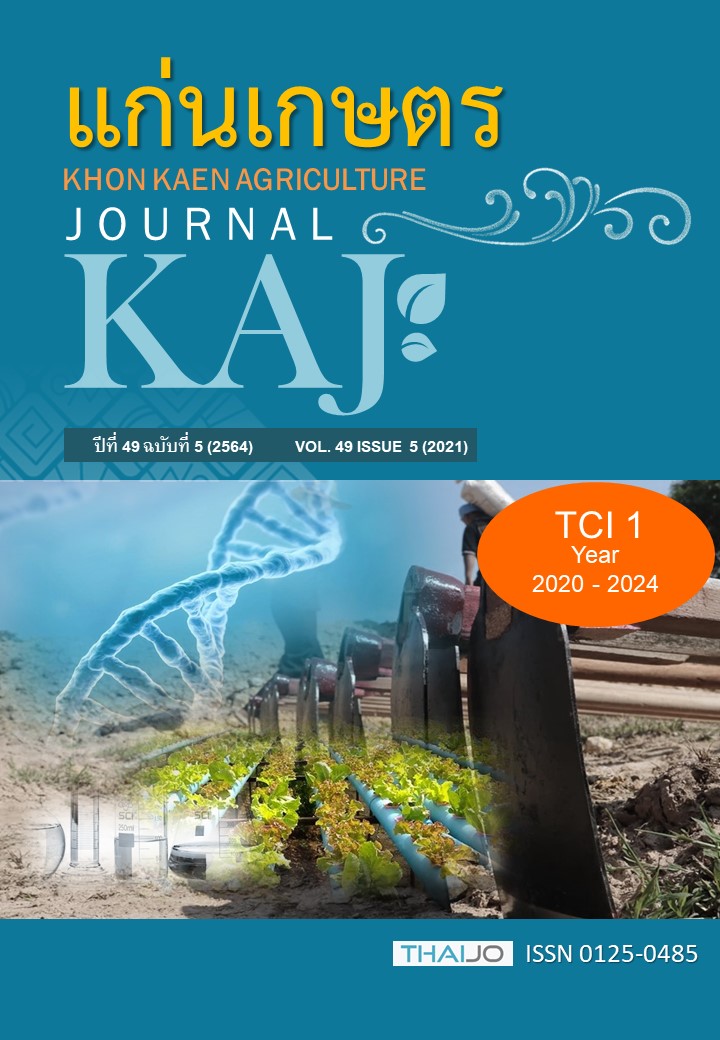เครื่องหมายดีเอ็นเอที่สัมพันธ์กับปริมาณแอนโทไซยานินและสีเยื่อหุ้มเมล็ดข้าวในประชากรชั่วที่ 2 ของคู่ผสมระหว่างพันธุ์ปทุมธานี 1 กับก่ำน้อย
Main Article Content
บทคัดย่อ
ข้าวที่มีเยื่อหุ้มเมล็ดสีม่วงเกิดจากการสะสมของแอนโทไซยานินสูง โดยการสังเคราะห์แอนโทไซยานินควบคุมด้วยยีนที่สำคัญ คือ OsB1 และ OsDFR ในงานวิจัยนี้มีวัตถุประสงค์เพื่อศึกษาความสัมพันธ์ระหว่างเครื่องหมายดีเอ็นเอที่จำเพาะกับยีน OsB1 และ OsDFR กับปริมาณแอนโทไซยานินในเมล็ดข้าวในประชากร F2 จำนวน 300 ต้น ของคู่ผสมระหว่างข้าวเยื่อหุ้มเมล็ดสีขาวพันธุ์แม่ปทุมธานี 1 กับข้าวเยื่อหุ้มเมล็ดสีม่วงพันธุ์พ่อก่ำน้อย การวิเคราะห์ความสัมพันธ์ระหว่างจีโนไทป์ของเครื่องหมายดีเอ็นเอกับปริมาณแอนโทไซยานินด้วยวิธี simple regression พบว่า เครื่องหมายดีเอ็นเอของยีน OsB1 เท่านั้นที่มีความสัมพันธ์กับปริมาณแอนโทไซยานิน (P<0.05) มีค่า R2 เท่ากับ 31.9% สีเยื่อหุ้มเมล็ดในประชากร F2 มีอัตราส่วนการเกิดสีและไม่เกิดสี คือ 3:1 โดยการเกิดสีเยื่อหุ้มเมล็ดต้องมีอัลลีลเด่นของยีน OsB1 อย่างน้อย 1 อัลลีล นอกจากนี้ การวิเคราะห์ปริมาณแอนโทไซยานินในประชากร F2 ด้วยวิธี HPLC พบต้นที่มี cyanidin-3-O-glucoside (C3G) สูงที่สุด เท่ากับ 39.52 มก./100 ก. เมล็ดแห้ง ซึ่งมีเยื่อหุ้มเมล็ดสีม่วงเข้ม ดังนั้น เครื่องหมายดีเอ็นเอของยีน OsB1 สามารถนำมาใช้คัดเลือกข้าวที่มีปริมาณแอนโทไซยานินและเยื่อหุ้มเมล็ดมีสีได้ตั้งแต่ระยะแรกของการเจริญเติบโต สะดวก รวดเร็ว และช่วยย่นระยะเวลาในการปรับปรุงพันธุ์ข้าวที่มีคุณค่าทางโภชนาการสูงได้
Article Details

อนุญาตภายใต้เงื่อนไข Creative Commons Attribution-NonCommercial-NoDerivatives 4.0 International License.
เอกสารอ้างอิง
กรมการข้าว. 2563. พันธุ์ข้าวปทุมธานี 1. แหล่งข้อมูล: http://www.ricethailand.go.th/Rkb/varieties/index.php-file=content.php&id=67.htm ค้นเมื่อ 15 ธันวาคม 2563.
จุฑาพร แสงประจักษ์. 2555. การใช้เครื่องหมายดีเอ็นเอสำหรับศึกษาความหลากหลายทางพันธุกรรม และการปรับปรุงพันธุ์ข้าว. แก่นเกษตร 40: 299-308.
รัชนี คงคาฉุยฉาย และริญ เจริญศิริ. 2553. คุณค่าโภชนาการของข้าวพันธุ์พื้นเมืองอำเภอกุดชุม จังหวัดยโสธร รายงานฉบับสมบูรณ์สถาบันโภชนาการ มหาวิทยาลัยมหิดล. นครปฐม.
อนงค์นาฏ หรี่จินดา, วราภรณ์ แสงทอง, แสงทอง พงษ์เจริญกิต และช่อทิพา สกูลสิงหาโรจน์. 2562. การใช้เครื่องหมายดีเอ็นเอของยีน OsB1 สำหรับใช้ตรวจสอบข้าวลูกผสมชั่วที่ 1 ของคู่ผสมระหว่างข้าวที่มีเยื่อหุ้มเมล็ดสีขาวและม่วง. น.181-189. ใน: การประชุมวิชาการพันธุศาสตร์แห่งชาติ ครั้งที่ 21. โรงแรมเดอะซายน์ พัทยา, ชลบุรี.
Ahmadiani, N., R. J. Robbins, T. M. Collins, and M. M. Giusti. 2016. Molar absorptivity (ε) and spectral characteristics of cyanidin-based anthocyanins from red cabbage. Food chemistry. 197: 900-906.
Guo, N., J. Wu, S. Zheng, F. Cheng, B. Liu, J. Liang, Y. Cui, and X. Wang. 2015. Anthocyanin profile characterization and quantitative trait locus mapping in zicaitai (Brassica rapa L. ssp. chinensis var. purpurea). Molecular Breeding. 35(5): 1-11.
Hwang, S.-K., and Y.-M. Kim. 2000. A simple and reliable method for preparation of cross-contamination-free plant genomic DNA for PCR-based detection of transgenes. Journal of Biochemistry and Molecular Biology. 33(6): 537-540.
Kim, J., H.-J. Lee, Y.-J. Jung, K.-K. Kang, W. Tyagi, M. Kovach, M. Sweeney, S. McCouch, and Y.-G. Cho. 2017. Functional properties of an alternative, tissue-specific promoter for rice NADPH-dependent dihydroflavonol reductase. PloS One. 12(8): e0183722.
Lee, J., R. W. Durst, and R. E. Wrolstad. 2005. Determination of total monomeric anthocyanin pigment
content of fruit juices, beverages, natural colorants, and wines by the pH differential method: collaborative study. Journal of AOAC international. 88(5): 1269-1278.
Lee, K. E., M. M. Rahman, J. B. Kim, and S. G. Kang. 2018. Genetic Analysis of Complementary Gene
Interactions of Pb and Pp Genes for the Purple Pericarp Trait in Rice. Journal of life science. 28(4): 398-407.
Lim, S.-H., and S.-H. Ha. 2013. Marker development for the identification of rice seed color. Plant Biotechnology Reports. 7(3): 391-398.
Nakai, K., Y. Inagaki, H. Nagata, C. MIYKZAKI, and S. IIDA. 1998. Molecular characterization of the gene for dihydroflavonol 4-reductase of japonica rice varieties. Plant Biotechnology. 15(4): 221-225.
Rahman, M. M., K. E. Lee, E. S. Lee, M. N. Matin, D. S. Lee, J. S. Yun, J. B. Kim, and S. G. Kang. 2013. The genetic constitutions of complementary genes Pp and Pb determine the purple color variation in pericarps with cyanidin-3-O-glucoside depositions in black rice. Journal of Plant Biology. 56(1): 24-31
Rahman, M. M., K. E. Lee, and S. G. Kang. 2016. Allelic gene interaction and anthocyanin biosynthesis of purple pericarp trait for yield improvement in black rice. Journal of Life Science. 26(6): 727-736.
Sakamoto, W., T. Ohmori, K. Kageyama, C. Miyazaki, A. Saito, M. Murata, K. Noda, and M. Maekawa. 2001. The Purple leaf (Pl) locus of rice: the Plw allele has a complex organization and includes two genes encoding basic helix-loop-helix proteins involved in anthocyanin biosynthesis. Plant and Cell Physiology. 42(9): 982-991.
Sakulsingharoj, C., P. Inta, R. Sukkasem, S. Pongjaroenkit, S. Chowpongpang, and V. Sangtong. 2016. Cloning and characterization of OSB1 gene controlling anthocyanin biosynthesis from Thai black rice. Genomics and Genetics. 9(1): 7-18.
Samyor, D., A. B. Das, and S. C. Deka. 2017. Pigmented rice a potential source of bioactive compounds: a review. International Journal of Food Science. 52(5): 1073-1081.
Somboon, P., C.Thebault Prom-u-thai, T. Pusadee, and S. Jamjod. 2017. Gene segregation for anthocyanin contents in F2 population between purple glutinous rice from highland and Pathum Thani 1 grown at lowland and highland locations. Journal of Agriculture. 33(3): 323-332.
Yang, X., X. Xia, Z. Zhang, B. Nong, Y. Zeng, Y. Wu, F. Xiong, Y. Zhang, H. Liang, and Y. Pan. 2019. Identification of anthocyanin biosynthesis genes in rice pericarp using PCAMP. Plant Biotechnology Journal. 17(9): 1700-1702.
Wang, C., and Q. Shu. 2007. Fine mapping and candidate gene analysis of purple pericarp gene Pb in rice (Oryza sativa L.). Chinese Science Bulletin. 52(22): 3097-3104.


